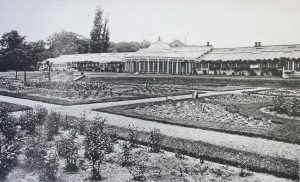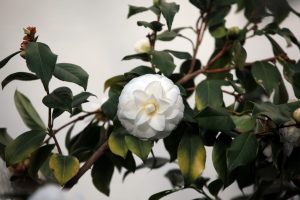2021 Camellia Celebration – A History of our Collection
With spring around the corner the frosted glass of the conservatory reflects a truly remarkable burst of life from the historic camellias within. From floor to ceiling rich red, pink and white blooms drip from the dark green foliage. The scene feels even more warming once the sunlight pierces through the glass.
This Grade 1 listed building was designed by the architect Samuel Ware, completed in 1813 it’s 330ft long and the earliest large glass house to be built, a forerunner of Decimus Burton’s glass house at Kew and Joseph Paxton’s Crystal Palace. The conservatory was built for the 6th Duke of Devonshire (1790 – 1858).

Originally the conservatory housed hot-house fruit, which were replaced in 1828 with an exciting new import from China: Camellia. Records tell us that these camellias were from Chandler and Buckingham of Vauxhall in London. They certainly were not cheap, costing between 3 and 5 Guineas in 1825; five weeks pay for an average earner.
The Camellias were originally kept in pots and likely planted into the conservatory beds around 1855. Camellias actually grow well outside, but at first it was thought that they should be planted under glass. Curtis’s Botanical Magazine of 1788 notes: “with us, the Camellia is generally treated as stove plant […] but it appears to be one of the properest plants imaginable for the conservatory”. In Cornwall, gardeners in the 1800s were already growing Camellia outside. Chiswick did not do so until after World War II.
At Chiswick House several of the original 40 varieties still survive, making the heritage collection probably the largest in Britain and possibly outside of China and Japan. The collection contains four of the first camellias introduced into Europe, Camellia japonica (c.1739), C. japonica ‘Rubra Plena’ (1794) C. japonica ‘Variegata’ (1792) and C. japonica ‘Alba Plena’ (1792).

The glasshouse and the Collection fell into ruin towards the end of the 20th Century. The plants were infested with mealy bug; thankfully in 1994 the collection was adopted by the International Camellia Society. Led by Jane Callander, with the support of Marigold Assinder and Herbert Short, the collection was rescued and revived and placed into the care of Chiswick House and Gardens Trust in 2007.
As part of the ongoing conservation, the Camellias are propagated and distributed across the globe. Even with our efforts some of these varieties are still rare.